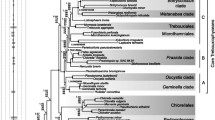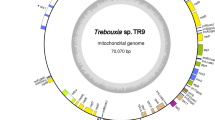Abstract
Red algae are one of the main photosynthetic eukaryotic lineages and are characterized by primitive features, such as a lack of flagella and the presence of phycobiliproteins in the chloroplast. Recent molecular phylogenetic studies using nuclear gene sequences suggest two conflicting hypotheses (monophyly versus non-monophyly) regarding the relationships between red algae and green plants. Although kingdom-level phylogenetic analyses using multiple nuclear genes from a wide-range of eukaryotic lineages were very recently carried out, they used highly divergent gene sequences of the cryptomonad nucleomorph (as the red algal taxon) or incomplete red algal gene sequences. In addition, previous eukaryotic phylogenies based on nuclear genes generally included very distant archaebacterial sequences (designated as the outgroup) and/or amitochondrial organisms, which may carry unusual gene substitutions due to parasitism or the absence of mitochondria. Here, we carried out phylogenetic analyses of various lineages of mitochondria-containing eukaryotic organisms using nuclear multigene sequences, including the complete sequences from the primitive red alga Cyanidioschyzon merolae. Amino acid sequence data for two concatenated paralogous genes (α- and β-tubulin) from mitochondria-containing organisms robustly resolved the basal position of the cellular slime molds, which were designated as the outgroup in our phylogenetic analyses. Phylogenetic analyses of 53 operational taxonomic units (OTUs) based on a 1525-amino-acid sequence of four concatenated nuclear genes (actin, elongation factor-1α, α-tubulin, and β-tubulin) reliably resolved the phylogeny only in the maximum parsimonious (MP) analysis, which indicated the presence of two large robust monophyletic groups (Groups A and B) and the basal eukaryotic lineages (red algae, true slime molds, and amoebae). Group A corresponded to the Opisthokonta (Metazoa and Fungi), whereas Group B included various primary and secondary plastid-containing lineages (green plants, glaucophytes, euglenoids, heterokonts, and apicomplexans), Ciliophora, Kinetoplastida, and Heterolobosea. The red algae represented the sister lineage to Group B. Using 34 OTUs for which essentially the entire amino acid sequences of the four genes are known, MP, distance, quartet puzzling, and two types of maximum likelihood (ML) calculations all robustly resolved the monophyly of Group B, as well as the basal position of red algae within eukaryotic organisms. In addition, phylogenetic analyses of a concatenated 4639-amino-acid sequence for 12 nuclear genes (excluding the EF-2 gene) of 12 mitochondria-containing OTUs (including C. merolae) resolved a robust non-sister relationship between green plants and red algae within a robust monophyletic group composed of red algae and the eukaryotic organisms belonging to Group B. A new scenario for the origin and evolution of plastids is suggested, based on the basal phylogenetic position of the red algae within the large clade (Group B plus red algae). The primary plastid endosymbiosis likely occurred once in the common ancestor of this large clade, and the primary plastids were subsequently lost in the ancestor(s) of the Discicristata (euglenoids, Kinetoplastida, and Heterolobosea), Heterokontophyta, and Alveolata (apicomplexans and Ciliophora). In addition, a new concept of “Plantae” is proposed for phototrophic and nonphototrophic organisms belonging to Group B and red algae, on the basis of the common history of the primary plastid endosymbiosis. The Plantae include primary plastid-containing phototrophs and nonphototrophic eukaryotes that possibly contain genes of cyanobacterial origin acquired in the primary endosymbiosis.
Similar content being viewed by others
Author information
Authors and Affiliations
Rights and permissions
About this article
Cite this article
Nozaki, H., Matsuzaki, M., Takahara, M. et al. The Phylogenetic Position of Red Algae Revealed by Multiple Nuclear Genes from Mitochondria-Containing Eukaryotes and an Alternative Hypothesis on the Origin of Plastids . J Mol Evol 56, 485–497 (2003). https://doi.org/10.1007/s00239-002-2419-9
Received:
Accepted:
Issue Date:
DOI: https://doi.org/10.1007/s00239-002-2419-9




